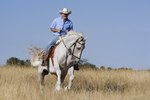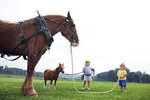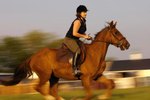
While horses usually get the credit for building America before the advent of the internal combustion engine, working cattle had just as much to do with the country's settlement. Teams of oxen -- castrated males over age 4 -- pulled farmers' plows and brought goods to market. A pair of steers -- or bullocks -- in harness can perform similar duties on small farms, but training must start when they are calves.
Choosing Calves
When choosing calves as a potential working team, look for healthy animals of approximately the same size. They should share a similar body type and build, moving in the same fashion. Look for straight-backed animals with wide chests. Suitable calves are neither overweight nor underweight. Dairy-breed male calves usually make better working animals than beef calves. If possible, try to match calves of the same color or markings, especially if you plan to compete your team.
Handling Calves
Before starting harness training, it's important that the calves get used to you and respect you. Handle them regularly, preferably every day. That doesn't mean just feeding and watering them. Groom them, pick up their feet for cleaning and take note of their individual temperaments. Get them used to halters and teach them to lead. Reprimand calves for any bad behavior, such as kicking. That doesn't mean striking the animal -- a sharp word usually does the trick. You don't want your working calves to fear you. The goal is to develop trust, so they will do their best for you when harnessed.
Yoking the Team
You can start yoking your calves together early on, using a 4-inch-long yoke, the wooden piece fastened over the necks that you'll eventually attach to a plow or cart. Once they're yoked, with halters on, have an assistant lead them while you follow behind with a buggy whip. Use the whip to guide the animals, not hit them. Keep initial sessions short. It will probably take several days or even weeks before the calves start walking forward reliably together.
Introducing Commands
Once your calves walk well together, start teaching them commands. Eventually they'll respond primarily to vocal cues. They need to learn "Whoa," along with "Gee" for a right turn and "Haw" for a left, with "Get up" or "Giddyup " to move forward. While "Back" is a necessary command, it's more difficult for calves to learn, as animals rarely back up in nature. Work on one command at a time until your calves "get it." While bovines take a while to learn something, once it's processed they don't forget. End every training session on a positive note.
Hitching the Team
Once your calves know their basic commands, you can try hitching them. Work with an assistant for these first forays. Start out by hitching your calves to a pole running between them. Once they get used to moving and turning with the pole, maneuvering around obstacles, attach a log or other object for them to drag. Once they're comfortable with dragging, hitch them to a cart or implement. The calves might become frightened of the cart, plow or other piece of equipment, so be prepared. With consistent training, your team will soon develop into reliable workers on your farm.
References
Photo Credits
-
Steve Baccon/Digital Vision/Getty Images
Writer Bio
Jane Meggitt has been a writer for more than 20 years. In addition to reporting for a major newspaper chain, she has been published in "Horse News," "Suburban Classic," "Hoof Beats," "Equine Journal" and other publications. She has a Bachelor of Arts in English from New York University and an Associate of Arts from the American Academy of Dramatics Arts, New York City.




